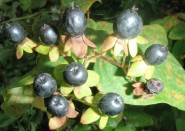Last Saturday we held a working bee, weeding at a site (which we do annually) where an invasion of Sycamore Maple seedlings entered the Park from a surrounding property. Initially we were pulling out hundreds of new seedling and now the ongoing effort to remove newly detected seedlings is working well. Like last year there was not a lot of Maple to remove and a lot of the time was spent moving through the site to ensure that the area was clean of weeds, (although we did not get cross to the other side of the gully where there are some more Maples growing). The main area where Maple was found was an open disturbed area that also has a very bad Tutsan infestation.
It was interesting to discover that much of the Tustsan in the area was covered by rust with some foliage looking quite heavily impacted. We didn’t notice the rust last year but when I looked back at some photos I took then, I did see that some Tutsan leaves had tell tale rust spots present. Tutsan Rust (Melampsora hypericorum) is a fungus that was found to be very successful in the Otway Ranges in the 1990’s where it had a significant impact on reducing the cover of this shade tolerant invasive weed.
Our site (or somewhere in a close vicinity) had Tutsan Rust artificially introduced a couple of years back and after some follow up inspections It was thought that it had not taken. After a bit of research I found a document that suggested that Tutsan Rust was already present at Tarra Bulga, A report from 1999 describes rust taken from Tarra Bulga (as well as some from the Morwell River area) being used as part of research project. The Tarra Bulga rust was found to impact the plants in the trial to an intermediate level (i.e. OK but not great). Whether or not the rust is from the attempted introduction a couple of years ago (of which I assume was a more virulent strain) or whether it is the same rust that has been around for longer, can probably not be known without complex Laboratory analysis. But we will continue to monitor the site with interest given the threat that Tutsan presents to the park.
As well as the Maple and Tutsan there were new Blackberry seedlings that we carefully hand pulled as well as a few new outbreaks of English Ivy which we need to remain vigilant for. There were some larger clumps of Blackberry that will need to be sprayed.







